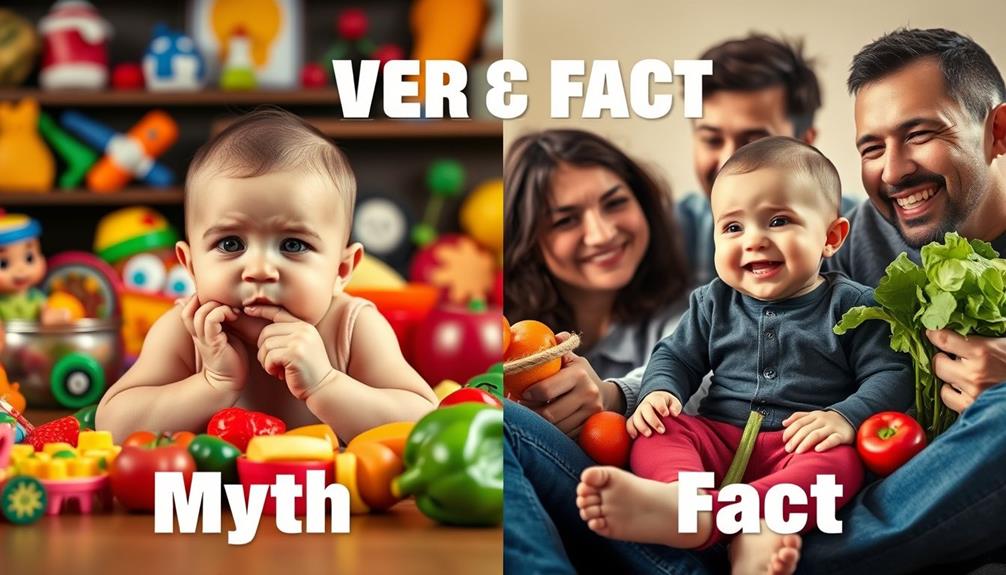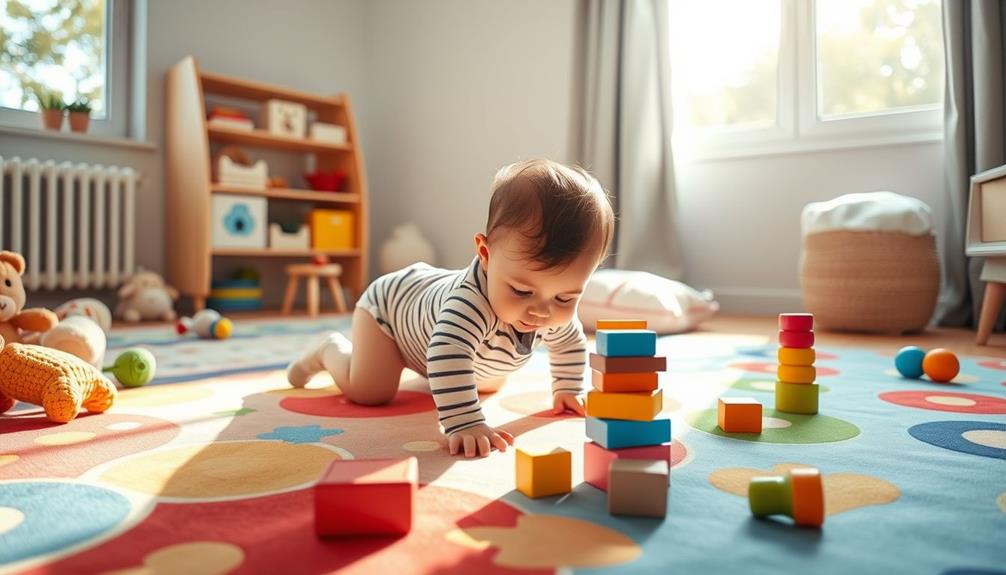Baby sign language empowers you to enhance communication with your intelligent infant, enabling them to express their needs and feelings well before they can talk. This early expression reduces reliance on crying, making for a happier home. Research shows that signing babies develop stronger cognitive skills, improved vocabulary, and higher IQs compared to non-signing peers. It also fosters emotional connections between you and your child, as they learn to articulate feelings like hunger or discomfort. By introducing fun activities and consistent practice, you can create a joyful learning experience. There's even more to discover about this enriching journey ahead!
Key Takeaways
- Baby sign language enables infants to express needs and feelings, reducing reliance on crying and enhancing mutual understanding with caregivers.
- Signing promotes cognitive development, resulting in a +12 point IQ advantage and improved vocabulary and reading skills.
- Early communication through signing fosters emotional intelligence, allowing infants to articulate feelings like hunger or discomfort, reducing frustration and tantrums.
- Shared signing activities strengthen the parent-child bond, promoting empathy and responsive caregiving while enhancing social skills through meaningful interactions.
- Engaging and fun learning environments, including games and music, make mastering baby sign language enjoyable and stimulate lifelong learning interest.
Benefits of Early Communication
Communicating early with your baby through sign language can transform the way you connect with them. By introducing baby sign language, you empower your infant to express their needs and feelings as early as six months. This early communication reduces their reliance on crying, making it easier for you to understand what they want.
Research indicates that babies exposed to sign language often acquire signs before spoken words, leading to improved language development and a richer vocabulary by age two. Furthermore, utilizing strategies like goal tracking can further enhance your approach to teaching sign language, allowing you to monitor progress and celebrate small milestones.
The benefits extend beyond vocabulary; signing helps your baby articulate emotions like hunger or fatigue, fostering emotional regulation. With better communication, you can respond more effectively to their needs, creating a sense of security for your child. This mutual understanding strengthens your bond, reducing frustration for both of you.
Additionally, studies show that signing babies have a +12 point IQ advantage, enhancing their cognitive abilities and memory retention. By incorporating sign language into your daily routine, you're not just teaching your baby to communicate; you're laying the groundwork for lifelong language skills and emotional intelligence, ensuring a brighter future for your little one.
Cognitive and Academic Advantages

Introducing baby sign language not only enhances early communication but also offers considerable cognitive and academic advantages. When you expose your baby to sign language, you're giving them a boost in cognitive skills that can lead to an impressive +12 point IQ advantage.
Research shows that signing infants often demonstrate improved reading skills and larger vocabularies than their non-signing peers. Additionally, engaging in activities that stimulate both cognitive and social development during early childhood, such as play the importance of play, can further enrich your child's learning experience.
By engaging both hemispheres of the brain through signing, you're aiding in synapse formation, which plays a vital role in brain development. This early exposure equips your child with better memory retention and overall cognitive abilities, setting the stage for stronger academic performance down the road.
Children who learn sign language typically develop greater communication skills and expressive language abilities as they grow. This foundation fosters a lifelong love of learning, making it easier for them to tackle new concepts and ideas.
Ultimately, incorporating baby sign language into your routine can greatly enhance your child's cognitive journey, paving the way for future academic success.
Enhancing Emotional Expression

While many parents seek ways to connect with their infants, baby sign language offers a powerful tool for enhancing emotional expression. By enabling your child to express their needs and feelings effectively, you can greatly reduce frustration and tantrums caused by miscommunication.
This method not only fosters communication but also bolsters your child's emotional intelligence. Additionally, understanding your child's emotional needs can lead to a more harmonious relationship, much like recognizing trust issues in relationships can strengthen adult connections.
Here are three key benefits of using baby sign language for emotional expression:
- Enhanced Emotional Awareness: Infants who learn to sign can label their feelings, leading to improved emotional regulation.
- Increased Self-Esteem: As your child articulates their emotions, such as hunger or discomfort, they gain confidence in expressing themselves.
- Stronger Trust: Engaging in sign language creates positive bonding experiences, deepening emotional connections between you and your infant.
Strengthening Parent-Child Bond

When you incorporate baby sign language into your routine, you're not just teaching your infant a new way to communicate; you're also nurturing a deeper bond between you and your child. This unique form of bonding fosters mutual understanding, making it easier for both of you to express needs and feelings.
As your infant learns to sign, you'll notice a significant reduction in frustration during communication, which strengthens your emotional connection. Additionally, just as effective training helps with communication in dogs, using sign language with your baby can enhance your interaction and responsiveness, similar to positive reinforcement methods in dog training.
Engaging in signing activities creates special moments, like celebrating your child's first signs. These shared experiences enhance attachment and allow for more responsive caregiving.
When you can interpret your child's signs, it promotes empathy and shows that you truly understand their needs, further deepening your bond.
Research indicates that effective communication through signing boosts confidence in both you and your child. The positive bonding experiences you create through signing can even lead to improved emotional regulation in your little one.
Developing Social Skills

Boosting your child's social skills starts with baby sign language, which encourages meaningful interactions with both peers and adults. By using sign language, you help your child engage in effective non-verbal communication, mirroring the importance of reviving old friendships in developing social connections. This interaction not only nurtures their confidence but also enhances vital social skills.
Here are three ways baby sign language fosters social skills:
- Improved Turn-Taking: Learning sign language teaches your child the art of turn-taking, essential for conversations and group interactions. They'll start to understand the rhythm of communication.
- Collaboration and Teamwork: Shared signing activities promote teamwork. When children sign together, they learn to work collaboratively, strengthening their friendships and building positive relationships.
- Awareness of Non-Verbal Cues: Engaging in sign language heightens your child's awareness of body language and facial expressions. This awareness is significant for effective social interaction and helps them read social situations better.
Incorporating sign language into your child's routine not only boosts their communication skills but also prepares them for successful interactions in various social settings.
With these skills, your child can navigate relationships with greater ease and confidence.
Creating a Fun Learning Environment

Creating a fun learning environment for baby sign language is all about engaging activities. By incorporating music and games, you can make lessons enjoyable and spark your child's interest in communication.
These playful interactions not only foster creativity but also help build a strong foundation for lifelong learning. Additionally, integrating technology into your teaching methods can further enhance engagement, as resources for parents provide innovative ways to support your child's development.
Engaging Activities for Learning
A vibrant learning environment can transform the process of mastering baby sign language into an enjoyable adventure. Incorporating engaging activities not only makes learning baby sign language fun but also lays a foundation for communication in early childhood.
Here are three effective activities you can try:
- Interactive Games: Use playful games that involve sign language. This not only stimulates your baby's creativity but also reinforces vocabulary through repetition.
- Visual Aids: Create flashcards and wall charts with signs. Having these quick reference points helps your baby recognize and recall signs more easily.
- Group Signing Activities: Engage in group signing sessions with peers. This encourages collaboration and develops your baby's social skills while making the learning process interactive.
Incorporating Music and Games
In the heart of early language development, incorporating music and games into baby sign language lessons can make all the difference. When you blend rhythmic patterns with signs, your baby becomes more engaged, making it easier for them to remember what they've learned.
Music creates a joyful atmosphere, while games encourage interactive learning, allowing your child to associate signs with fun activities.
Research shows that playful environments stimulate creativity and imagination, both essential for cognitive development and language skills. You can introduce sign-based games that motivate exploration, fostering a lifelong love of communication.
These engaging activities not only make learning enjoyable but also help reduce frustration and tantrums, promoting emotional regulation.
As you and your baby play and sing together, you establish positive associations with language acquisition, enhancing the bond between you.
This joyful approach to learning transforms sign language practice into a delightful experience, paving the way for effective communication.
Tools for Effective Signing

Effective tools can make a significant difference when teaching baby sign language. By utilizing the right resources, you can enhance your child's learning experience and support their communication development. Here are three essential tools to evaluate:
1. Dictionaries for Baby Sign Language: These specialized dictionaries can help you find and learn various signs, aiding in vocabulary expansion for both you and your child.
Additionally, exploring key factors in choosing a home cleaning service can provide insights into creating a clean environment that fosters focus during learning sessions.
2. Flashcards: Visual learning with flashcards reinforces sign recognition and memory. They make it easier for your infant to associate signs with their meanings, promoting quicker understanding.
3. Wall Charts: These serve as quick reference tools, allowing you to visually track and remind yourself of the signs you want to teach. This can keep your learning focused and consistent.
Incorporating these tools into your daily routine encourages natural usage of signs, enhancing your child's communication skills.
Additionally, interactive methods like music and games can make the learning process enjoyable, creating a positive association with signing.
With consistent practice and the right tools, you'll foster your child's development in signing and communication!
Overcoming Challenges With Signing

Overcoming challenges with baby sign language can be an important part of enhancing your child's communication skills. While introducing sign language to young children may come with hurdles, the benefits far outweigh the difficulties.
One common challenge is consistency; it's vital to use the signs regularly to help your child grasp their meaning. Engaging in fun signing activities and incorporating sensory experiences, like aromatherapy with essential oils for relaxation, fosters a positive learning environment and motivates your infant to communicate.
You might also find that your child struggles to express emotions initially, leading to frustration or tantrums. By providing them with sign language tools, you empower them to communicate their needs, reducing those outbursts.
In addition, practicing sign language enhances social skills, as your child learns to interact with caregivers and peers. This interaction promotes cooperation and can create a richer social experience.
Lastly, remember that patience is key. Cognitive development flourishes when you encourage early communication through signs. Studies have linked sign language use to higher IQ scores and advanced vocabulary acquisition, emphasizing the long-term advantages of overcoming these initial challenges.
Embrace the journey, and soon you'll witness the rewarding outcomes of signing with your little one.
Future of Baby Sign Language

Future of Baby Sign Language
Researchers are increasingly exploring the future of baby sign language, aiming to uncover innovative ways to enhance language acquisition in infants. As you engage in teaching sign language to your little one, it's exciting to think about how future studies will shape this practice.
Understanding the impact of narcissistic behaviors can also provide insights into the emotional dynamics that may affect communication in early development.
- Teaching Multiple Signs: Future research will focus on combining multiple signs with relevant stimuli, helping early children learn in varied environments.
- Long-term Effects: Investigations will assess how early sign language training impacts behavioral outcomes and communication skills, especially for at-risk populations.
- Generalization Across Contexts: Studies will aim to understand how sign training can be generalized across different contexts and listeners, broadening its implications for language development.
Continued research is vital for identifying effective sign training techniques for parents and caregivers.
By maximizing communication outcomes, you can foster your infant's language skills early on. Future findings may also highlight the potential of baby sign language in preventing behavioral issues related to language delays, underscoring its significance in early childhood development.
Embracing these advancements will empower you and your child on the journey of communication.
Frequently Asked Questions
What Are the Benefits of Baby Sign Language for the Baby?
When you teach your baby sign language, you're opening up a world of benefits. Your little one can express needs and feelings earlier, reducing frustration and tantrums.
You'll notice they develop larger vocabularies and improved literacy skills as they grow. Signing also enhances emotional regulation, helping them communicate feelings like hunger or tiredness.
Plus, this shared experience strengthens your bond, promoting secure attachments and better social interaction skills as they navigate their world.
How Do You Stimulate an Intelligent Baby?
To stimulate your intelligent baby, engage them in interactive play that challenges their thinking. Use colorful toys, puzzles, and sensory activities to spark curiosity.
Incorporate music and movement, allowing them to explore rhythm and coordination. Read together daily, choosing vibrant books that capture their attention.
Encourage exploration by providing safe spaces for crawling or walking. Remember, consistent interaction and exposure to new experiences will foster their cognitive growth and keep their minds active.
What Is the Sign That Your Baby Is Intelligent?
Isn't it fascinating how early signs of intelligence can manifest in your baby?
If your little one starts to communicate their needs through gestures before they can speak, that's a strong indicator of intelligence. You might notice them showing curiosity or problem-solving skills during playtime.
Their ability to engage with you and express emotions suggests they're not just absorbing information but actively processing it.
Recognizing these signs can help you nurture their budding intellect.
Does Learning Sign Language Increase Iq?
Yes, learning sign language can increase IQ.
When you expose your child to sign language early on, you're not just teaching them to communicate; you're engaging their brain in a unique way. This early exposure boosts cognitive abilities, leading to larger vocabularies and better academic performance.
The visual nature of signing helps with memory retention, enhancing their overall intellectual development.
Conclusion
Incorporating baby sign language into your daily routine can transform your communication with your little one into a superpower! Not only does it foster early communication, but it also builds a stronger bond and enhances emotional expression. As you navigate this exciting journey together, you'll discover a fun and engaging way to connect with your intelligent infant. So, embrace the joy of signing and watch your baby's world—and yours—expand in ways you never thought possible!










